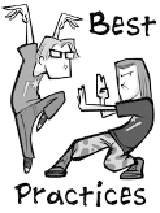Game Development Reference
In-Depth Information
There are plenty of standard conventions for input devices, from Microsoft Windows
to first-person shooters on the PC. When you sit down to write your interface code,
consider your control scheme carefully and make a conscious decision whether you
want to stay with a well-known convention or go in a totally new direction. You take
a risk with going rogue on user interface controls, but it can pay off, too. After all,
before the shooter-style game was popular, how many games used the mouse as a
model for a human neck? This idea worked well in a case like this for two reasons:
It solved a new problem, and the solution was intuitive.
If It Ain
'
t Broke, Don
'
t Fix It
If you
re solving an interface problem that has a standard solution and you
choose a radically different approach, you take a risk of annoying players. If
you think their annoyance will transition into wonder and words of praise as
they discover (and figure out) your novel solution, then by all means give it a
try. Make sure that you test your idea first with some people you trust. They
'
'
ll
tell you if your idea belongs on the garbage heap.
After them, try the idea out on real players you
ve never met. Be careful with
interfaces, though. A friend of mine once judged the many entrants into the
Indie Games Festival
(www.indiegames.com),
and he said the biggest mistake
he saw that killed promising entrants was poor interface controls. He was
amazed to see entries with incredible 3D graphics not make the cut because
they were simply too hard to control.
'
What
s worse, even game professionals get caught in this problem. The big retail buyers will give your
game just a few minutes, and if they can
'
'
t figure out your control scheme, they won
'
t buy your game.
Believe me,
if someone like Walmart or Best Buy doesn
'
t buy your game, you are destined for the
unemployment line. In short, don
'
t be afraid to use a good idea just because it
'
s already been done.
Be cautious with overloading simple controls with complicated results.
Context
sensitivity in controls can be tough to deal with as a player. It
s easy to make the mis-
take of loading too much control onto too little a device. The Ultima games generally
went a little too far, I think, in how they used the mouse. A design goal for the games
was to have every conceivable action be possible from the mouse, so every click and
double-click was used for something. In fact, the same command would do different
things if you clicked on a person, a door, or a monster. I
'
m sometimes surprised that
we never implemented a special action for the
'
click.
Give the player some feedback.
One thing I think the Ultima games did well, and many
others since, was how they used the cursor, or reticle image. As it floated over different
objects, it would change shape to give the player feedback about what things were and
whether they could be activated by a button press. This is especially useful when your
screens are very densely populated. When the reticle changes shape to signify that the
“
shave and a haircut, two bits
”



